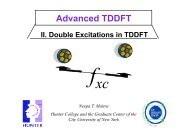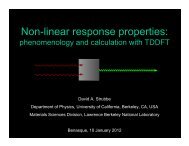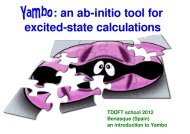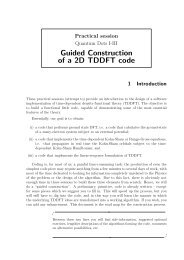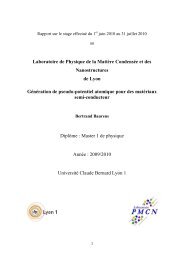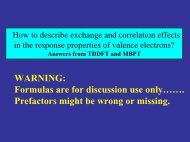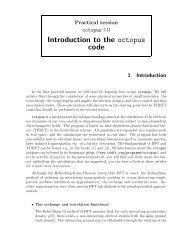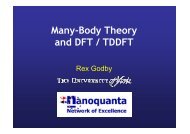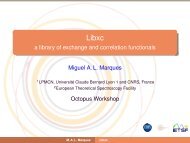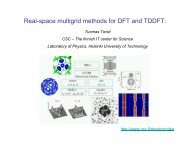Long-range correction effects on the evaluation of first ... - TDDFT.org
Long-range correction effects on the evaluation of first ... - TDDFT.org
Long-range correction effects on the evaluation of first ... - TDDFT.org
Create successful ePaper yourself
Turn your PDF publications into a flip-book with our unique Google optimized e-Paper software.
LC <str<strong>on</strong>g>effects</str<strong>on</strong>g> <strong>on</strong> <strong>the</strong> evaluati<strong>on</strong> <strong>of</strong> β<br />
<strong>of</strong> high intrinsic<br />
hyperpolarizability molecules.<br />
Cláudia Cardoso, Universidade de Coimbra
F, external<br />
Study <strong>the</strong> n<strong>on</strong>linear<br />
optical resp<strong>on</strong>se <strong>of</strong><br />
<strong>org</strong>anic molecules<br />
Study <strong>of</strong> <strong>the</strong> molecules<br />
with high intrinsic<br />
hyperpolarizability<br />
applied field<br />
Technological Applicati<strong>on</strong>s:<br />
signal processing,<br />
optical data storage,<br />
etc.<br />
, <strong>first</strong><br />
hyperpolarizability
How to compare different<br />
molecules?<br />
●<br />
two molecules with <strong>the</strong> same β but different<br />
number <strong>of</strong> π electr<strong>on</strong>s are not intrinsically<br />
equivalent.<br />
●<br />
quantum sum rules impose limits <strong>on</strong> <strong>the</strong> <strong>first</strong><br />
and sec<strong>on</strong>d hyperpolarizabilities.
fundamental limit:<br />
N: effective<br />
number <strong>of</strong><br />
polarizable<br />
electr<strong>on</strong>s<br />
M. G. Kuzyk, Phys. Rev. Lett. 85, 1218 (2000)<br />
Intrinsic<br />
Hyperpolarizability:
e- acceptor<br />
group<br />
e- d<strong>on</strong>or<br />
group<br />
<str<strong>on</strong>g>L<strong>on</strong>g</str<strong>on</strong>g> pi bridge<br />
Optimizati<strong>on</strong> <strong>of</strong>...<br />
●<br />
●<br />
<strong>the</strong> electr<strong>on</strong>-d<strong>on</strong>ating/withdrawing strengths <strong>of</strong><br />
<strong>the</strong> terminal d<strong>on</strong>or and acceptor groups<br />
c<strong>on</strong>jugati<strong>on</strong> path
1<br />
4<br />
2<br />
5<br />
3<br />
6<br />
7
Experimental Results<br />
The best molecules are <strong>on</strong>es that<br />
are l<strong>on</strong>g with many undulati<strong>on</strong>s in<br />
<strong>the</strong> potential energy functi<strong>on</strong>,<br />
which allows <strong>the</strong> electr<strong>on</strong> densities<br />
<strong>of</strong> <strong>the</strong> eigenstates to be well<br />
separated.<br />
OPTICS LETTERS Vol. 32, 59 2007<br />
Recipe<br />
● increased length<br />
● linear chain<br />
● mimic <strong>the</strong> optimal undulati<strong>on</strong><br />
● make use <strong>of</strong> aromatic moieties with a<br />
wide <str<strong>on</strong>g>range</str<strong>on</strong>g> <strong>of</strong> stabilizati<strong>on</strong> energies
Calculati<strong>on</strong><br />
Method<br />
●<br />
Geometries optimizati<strong>on</strong><br />
●<br />
β : Finite field calculati<strong>on</strong><br />
● Semi-empirical calculati<strong>on</strong>s :<br />
●<br />
<strong>TDDFT</strong> absorpti<strong>on</strong> spectra<br />
●<br />
PM6 Hamilt<strong>on</strong>ian (COSMO)<br />
DFT / <strong>TDDFT</strong>:<br />
B3LYP / 6-311G(d,p)+<br />
LC-BLYP/ 6-311G(d,p)+<br />
Solvent <str<strong>on</strong>g>effects</str<strong>on</strong>g>: PCM<br />
●<br />
●<br />
Aim:<br />
Reproduce <strong>the</strong> exp. values<br />
Understand <strong>the</strong> role <strong>of</strong> <strong>the</strong><br />
different c<strong>on</strong>jugati<strong>on</strong> paths
Gas-phase calculati<strong>on</strong>s underestimate β<br />
Calculati<strong>on</strong>s do<br />
not reproduce<br />
increase for<br />
MOL6 and MOL7<br />
(au)<br />
1.2E+5<br />
9.0E+4<br />
6.0E+4<br />
exp<br />
PM6<br />
DFT<br />
DFT:<br />
1,2,4 OK!<br />
3.0E+4<br />
0.0E+0<br />
0 1 2 3 4 5 6 7 8<br />
molecules
Solvent <str<strong>on</strong>g>effects</str<strong>on</strong>g> improve (some) results<br />
PM6:<br />
Solvent improves<br />
trend<br />
Mols 6, 7 not<br />
well reproduced<br />
(au)<br />
2.0E+5<br />
1.5E+5<br />
1.0E+5<br />
exp<br />
PM6<br />
DFT<br />
DFT/B3LYP:<br />
1,2,4 KO!<br />
5.0E+4<br />
0.0E+0<br />
0 1 2 3 4 5 6 7 8<br />
molecules
Molecules under study<br />
1<br />
4<br />
2
DFT B3LYP<br />
2.0E+5<br />
1.5E+5<br />
exp<br />
vac<br />
dmso<br />
(au)<br />
1.0E+5<br />
5.0E+4<br />
0.0E+0<br />
0 31 52 63 47 5 16 27 48 9<br />
molecules
Wr<strong>on</strong>g geometry?<br />
mol2<br />
Increasing <strong>the</strong><br />
torsi<strong>on</strong> angle:<br />
Fast energy<br />
increase<br />
Low decrease<br />
9E+4<br />
6E+4<br />
B3LYP+solv.<br />
exp<br />
Azobenzene:<br />
“(...) <strong>the</strong> energetic difference<br />
between <strong>the</strong> planar and twisted<br />
forms is ei<strong>the</strong>r zero or totally<br />
negligible at room temperature.”<br />
L. Briquet et al, Chem. Phys. Lett.,<br />
417, 2006, 190<br />
(au)<br />
3E+4<br />
0E+0<br />
0 10 20 30 40 50 60 70 80<br />
Torsi<strong>on</strong> angle (º)
Orbitals:<br />
HOMO<br />
mol4<br />
mol7
Orbitals:<br />
LUMO<br />
mol4<br />
mol7
<str<strong>on</strong>g>L<strong>on</strong>g</str<strong>on</strong>g> Range<br />
<str<strong>on</strong>g>correcti<strong>on</strong></str<strong>on</strong>g>s<br />
<str<strong>on</strong>g>L<strong>on</strong>g</str<strong>on</strong>g> molecules<br />
– Sekino et al. J. Chem.<br />
Phys. 126, 014107 2007<br />
Str<strong>on</strong>g e-<br />
d<strong>on</strong>ors/acceptors<br />
The β ratio <strong>of</strong> BLYP and<br />
HF increases<br />
m<strong>on</strong>ot<strong>on</strong>ically<br />
– J. Phys. Chem. A, Vol.<br />
113, No. 6, 2009 Loboda<br />
et al.
<str<strong>on</strong>g>L<strong>on</strong>g</str<strong>on</strong>g> <str<strong>on</strong>g>range</str<strong>on</strong>g> <str<strong>on</strong>g>correcti<strong>on</strong></str<strong>on</strong>g>s<br />
●<br />
DFT and HF exchange c<strong>on</strong>tributi<strong>on</strong>s are<br />
partiti<strong>on</strong>ed at <strong>the</strong> operator level.<br />
●<br />
The electr<strong>on</strong> repulsi<strong>on</strong> operator, 1/ r12, is<br />
partiti<strong>on</strong>ed using <strong>the</strong> error functi<strong>on</strong><br />
●<br />
n<strong>on</strong>local HF part becomes larger for greater<br />
distances.<br />
GAMESS | Y.Tawada et al J.Chem.Phys. 120, 8425 (2004)
LC improves calculated β<br />
2.0E+5<br />
1.5E+5<br />
exp<br />
LC-BLYP<br />
B3LYP<br />
Large<br />
difference<br />
for molecules<br />
1, 2, 4<br />
(au)<br />
1.0E+5<br />
5.0E+4<br />
Still problems<br />
with mol 2...<br />
and 7<br />
0.0E+0<br />
0 31 52 63 47 5 61 72 84<br />
9<br />
molecules
Different<br />
c<strong>on</strong>formers<br />
ΔE = 0.16 eV<br />
2E+5<br />
mol2<br />
(au)<br />
1E+5<br />
5E+4<br />
exp<br />
LC<br />
0E+0<br />
0 1 2 3 4 5 6 7 8<br />
ΔE = 0.09 eV
Mols 6 and 7 are isoelectr<strong>on</strong>ic but<br />
<strong>the</strong> additi<strong>on</strong>al Cl atom in molecule<br />
6, induces a twist in <strong>the</strong> c<strong>on</strong>jugati<strong>on</strong><br />
path, resulting in a decreased<br />
hyperpolarizability.<br />
x<br />
mol7<br />
mol6
B3LYP + solvent:<br />
Huge effect <strong>on</strong><br />
mols 1, 2, 4<br />
2.0E+5<br />
1.5E+5<br />
1.0E+5<br />
exp<br />
B3LYP –<br />
vac<br />
B3LYP –<br />
dmso<br />
LC/BLYP –<br />
dmso<br />
2E+5<br />
2E+5<br />
1E+5<br />
5E+4<br />
mol4<br />
mol7<br />
0E+0<br />
5.0E+4<br />
-5E+4<br />
0.0E+0<br />
0 1 2 3 4<br />
-1E+5<br />
PM6 B3LYP LC PM6 B3LYP LC<br />
Gas phase<br />
DMSO
Solvent and LC:<br />
Same effect <strong>on</strong><br />
mol 4 and 7<br />
0<br />
LC:<br />
B3LYP LC-BLYP<br />
B3LYP+solv LC-BLYP+solv<br />
opens <strong>the</strong> gap<br />
B3LYP LC-BLYP<br />
B3Lyp+solv LC-BLYP+solv<br />
-0.1<br />
Solvent:<br />
closes <strong>the</strong><br />
gap<br />
E (Hartree)<br />
-0.2<br />
-0.3<br />
HOMO-1<br />
HOMO<br />
LUMO<br />
LUMO+1<br />
mol4<br />
mol7<br />
-0.4
LC solvent<br />
Have opposite<br />
<str<strong>on</strong>g>effects</str<strong>on</strong>g><br />
LC effect<br />
larger for mol4<br />
LC+solvent<br />
Coincides with<br />
B3LYP-vac
3<br />
8<br />
6<br />
E01 (eV)<br />
2<br />
1<br />
B3LYP<br />
LC-BLYP<br />
Transiti<strong>on</strong> dipole<br />
4<br />
2<br />
B3LYP<br />
LC-BLYP<br />
0<br />
0 1 2 3 4 5 6 7 8<br />
molecules<br />
Two level model:<br />
2.0E+5<br />
1.5E+5<br />
1.0E+5<br />
0<br />
0 1 2 3 4 5 6 7 8<br />
B3LYP<br />
LC-BLYP<br />
exp<br />
molecules<br />
5.0E+4<br />
0.0E+0<br />
0 1 2 3 4 5 6 7 8<br />
molecules
C<strong>on</strong>clusi<strong>on</strong>s<br />
●<br />
●<br />
LC BLYP + solvent reproduce exp.<br />
Two sets <strong>of</strong> molecules<br />
1. Mols 1,2,4: Azo-benzene<br />
2. Mols 3, 5, 6, 7<br />
● LC important for group 1<br />
●<br />
●<br />
Solvent and LC have opposite <str<strong>on</strong>g>effects</str<strong>on</strong>g><br />
transiti<strong>on</strong>s dipoles and excitati<strong>on</strong> energies<br />
follow hyperpolarizability trends



